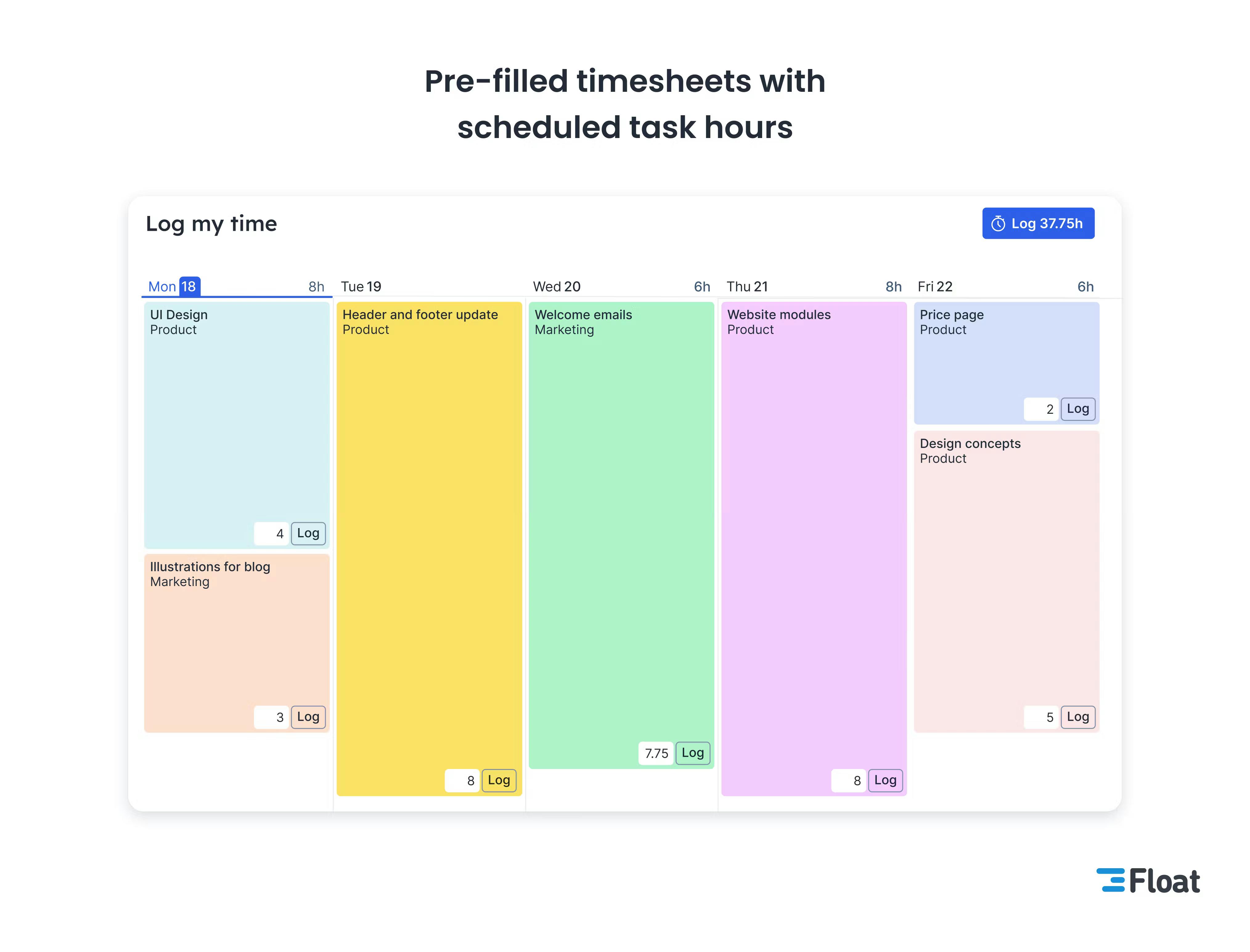Timesheets are useful time tracking tools for measuring team productivity, increasing accountability, and improving the billing process.
Excel timesheets are the basic, tried-and-true method of logging hours—although many powerful software applications can help automate the more mundane aspects of tracking time much better than sheets 😉
Here are some free Google Sheets and Excel templates you can get started right away.
5 free timesheet templates
Depending on your needs, you can use a daily, weekly, or monthly time tracking spreadsheet template. If you prefer paper timesheets, you can use our printable timesheet templates.
How to use these time tracking templates → click the links to open up the full template in both Excel and Google Sheets. From Google Sheets, you can easily copy the template to your own Google account or download it as an Excel sheet. Access to the template itself will be view-only because the original version needs to remain intact for others to use, too!
1. Daily timesheet template
Teams can use a time tracking spreadsheet to log time daily. This spreadsheet is great for tracking activities carried out throughout the day and gives back a granular overview of what work has been done.
It is more accurate than weekly or monthly spreadsheets because most people remember what tasks they worked on immediately after completing them.
Daily timesheet templates are usually best for contractors, freelancers, or employees who record their activities by the hour.

Save more time with this daily timesheet template
Download Excel spreadsheet here
2. Weekly timesheet template
A weekly time tracking spreadsheet tracks employees’ total hours during the standard work week (usually five days). A weekly timesheet is generally filled out at the end of each week.
One downside to this method is that it’s usually not as accurate as a daily time tracking spreadsheet: since team members only fill it out once a week, they might forget how they spent their daily hours.

Save more time with this weekly timesheet template
Download Excel spreadsheet here
3. Biweekly timesheet template
Biweekly (or fortnightly) time tracking spreadsheets are used to track employee hours over two weeks. A benefit of using this setup is that there are fewer spreadsheets to review than if you were tracking daily or weekly.
This timesheet template may be best for you if you process payroll every other week.

Save more time with this biweekly timesheet template
Download Excel spreadsheet here
4. Monthly timesheet template
A monthly time tracking spreadsheet is used to measure the work hours on a monthly basis.
Monthly timesheets mean reviewing and signing off on fewer documents—saving you time. They work best for businesses with a monthly pay period or salaried staff.

Save time with this monthly timesheet template
Download Excel spreadsheet here
5. Project timesheet template
Project time tracker spreadsheets track freelancer/employee time throughout a specific project.
These spreadsheets are more granular, showing exactly how much time is spent on specific tasks, making it easy to bill clients for work.

Save time with this project timesheet template
Download Excel spreadsheet here
How to create a timesheet in Excel
If you would like to create a time tracker spreadsheet on your own, here are some steps to follow:
Step 1: start with a blank spreadsheet
Launch the Microsoft Excel application and select ‘New blank workbook.’

Step 2: fill in personnel information
Create fields to fill in your team information; include fields like name, department, date, etc.

Step 3: create categories
In each row below the personnel information, write what you want to track. For example, in a weekly time tracking spreadsheet, your fields might include tasks, days (Monday through Friday), work hours, start time/end time, and overtime.

Step 4: use formulas
Insert formulas in relevant cells.
For instance, if you want to total the hours worked on Monday automatically, you can use the formula =SUM(B4:B9).
If you want to generate the total amount due for the week, use the formula =(G11*I4)*24.

Learn how to create and manage timesheets effectively.
Are time tracking spreadsheets the best way to track time?
...nope.
Time tracking spreadsheets are easy to set up and affordable, but they are not the most efficient way to track your team’s time:
- It takes to maintain and review spreadsheets—employees enter their data manually, and managers review time entries to detect discrepancies (not to mention the constant reminders to employees to fill their timesheets)
- Mistakes, human errors, and even fake data can (and will!) happen with time-consuming manual timesheets. If someone is filling out their weekly timesheet at 4.45pm on Friday, should they be expected to remember what they worked on from 10am to 12pm on Monday? We all know what the answer is.
- While it’s possible to generate reports and foreplan using a spreadsheet, most people aren’t Excel gurus. There’s a lot of head-scratching and trial and error involved in figuring out how much time has been spent on a specific task or how many billable hours there are.
- Also, it is hard to get insights for better project planning. Spreadsheets do not automatically provide reports comparing the estimated time planned for a project to the actual time spent completing it.
...so here’s a better and more reliable way to track time
There is some good news: spreadsheet are not the only option. Time tracking software works perfectly for this use case—it can be easy and efficient for your employees, and give you all the information you need to plan ahead confidently.
A timesheet software like Float (hey 👋 ) allows you to plan and track employee hours in one place for minimal manual input and maximum accuracy.
Here’s how it works:
1. Pre-filled timesheets
Your team’s assigned tasks are used to create pre-filled timesheets containing all of their planned work and any overtime or time off. These pre-filled timesheets based on scheduled tasks let team members bulk log a week of hours in one click.

2. Log time for each task
Clicking on a task allows a person to adjust the time they spent on a task before submitting it for review. Or (if everything is already accurate), they can press Log to submit their hours at once.

You can lock logged time from within the team settings to prevent changes after a timesheet has been filled.
.gif)
3. Sync with payroll
Teams can customize their time logs and set tasks as billable or non-billable. You can also use the project budget feature to set hourly rates for billable tasks at either a project or individual level.
Additionally, timesheets can be exported to invoicing tools like Xero and Quickbooks via direct integration for easy billing.
To see how a team member spends their time, select a specific date range, filter people or tasks, and generate a report.

You can compare project estimates vs. actuals to plan tasks and forecast timelines more accurately.
Before setting up spreadsheets and getting buy-in from the team, consider using a software solution that could lighten the burden for you and your team!
Ready to start tracking time the easy way? Try Float for free.
<cta-box>
<image-color="blue">
Automate your time tracking with Float
Pre-fill your team’s timesheets with their scheduled task hours, and compare your estimates vs. actuals in one place. More than 4,500 of the world's top teams plan and track their time with Float.
<cta-button>Check it out</cta-button>
</cta-box>
Some FAQs about timesheets
What is a timesheet?
A timesheet is a tool used to record the amount of time spent on various tasks or activities. It typically includes columns for the task name, start time, end time, duration, and any additional notes.
What are the benefits of using a time tracking spreadsheet over other methods?
Time tracking spreadsheets are flexible, customizable, and easily accessible. They allow for detailed tracking of time spent on different activities, easy analysis of time usage patterns, and user-friendly integration with other tools and systems.
Can I integrate a time tracking spreadsheet with other tools or software?
Yes! many time tracking spreadsheets can be integrated with other tools or software, such as project management systems, invoicing software, or calendar applications, to streamline workflows and improve efficiency.











